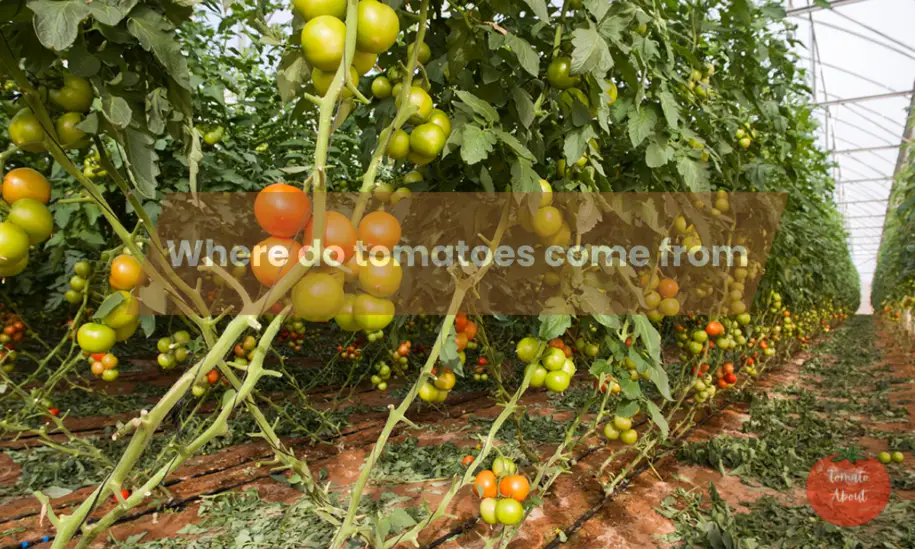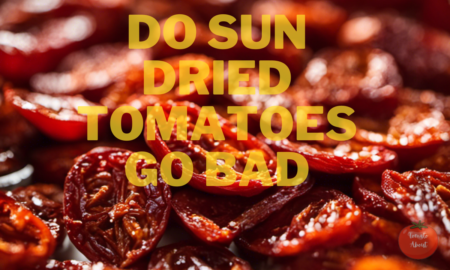Tomatoes are one of the most popular vegetables in kitchens around the world. Their delicious, versatile flavor makes them a staple ingredient in countless recipes. But have you ever wondered where those bright red gems in your salad or sauce originally came from?
The route a tomato takes from a small seed to your dinner table is a fascinating one. So let’s trace the origins and growing process to learn more about this nutritious nightshade fruit.
The story of the tomato is a captivating 6000-year journey that takes us from the Andean mountains of Peru to the Nahuatl people of Mexico and ultimately to Italy, the United States, and beyond.
The Wild Ancestors of the Modern Tomato
The ancient ancestors of tomatoes grew wild in the Andean mountains of modern-day Peru, Chile, Ecuador, and Bolivia. These wild tomato plants likely first evolved around 6000 years ago.
Archaeological evidence shows that ancient civilizations in Peru were eating wild tomatoes as early as 700 AD. The earliest domesticated tomato seeds have been found at sites dating back to 500 BC.
These early tomatoes were drastically different from the plump, red tomatoes we know today. The wild ancestors were small, spherical berries with a diameter of just 1-2 centimeters. They ranged in color from green to yellow to red when fully ripe.
Around 200 BC, a mutation occurred resulting in tomato plants with oval-shaped fruits. This kicked off the long process of selective breeding to develop bigger, meatier tomatoes better suited for cooking.
Nahuatl People Domesticate the Tomato in Mexico
The true domestication of the tomato into a recognizable food crop began with the Nahuatl-speaking people of Central Mexico. The Nahuatl, who likely descended from tribes in northern Mexico and the American Southwest, were among the earliest and most advanced civilizations in Mesoamerica.
Around 700-800 AD, the Nahuatl began cultivating tomatoes, which they called xitomatl. They started modifying the wild tomatoes into larger, fleshier fruits through selective planting of seeds from the biggest specimens.
The Nahuatl cooked tomatoes with peppers, corn, and spices to make some of the earliest salsas and sauces. Archaeological evidence shows they used tomatoes in these dishes as early as 900 AD.
Besides eating them, the Nahuatl also used tomatoes medicinally. They would treat headaches and other ailments by tying tomatoes to their foreheads and wounds.
By the time Spanish conquistador Hernán Cortés arrived in the early 1500s, tomato cultivation was flourishing across Central America. After the Spanish conquest, they brought tomatoes back to Europe along with other New World crops like potatoes, corn, and peppers.
Tomato Arrives in Europe – But Not Without Controversy
Tomatoes first arrived in Europe by the early 1500s, though some scholars suggest they first came to Spain and Italy as early as 1523. However, tomatoes were initially met with suspicion when introduced in Europe.
The main issue was that tomatoes were part of the nightshade family, which includes toxic plants like belladonna. Many feared tomatoes were also poisonous. There are even reports of wealthy Europeans using tomatoes to poison unwanted guests.
Beyond potential toxicity, many Europeans were repulsed by tomatoes’ fleshy texture and seeds. One French botanist deemed them “slimy” and “nauseating” In the mid-1600s. Even years after their introduction, many Mediterranean cookbooks from the 1700s omit tomatoes from recipes entirely.
However, some intrepid souls dared try this exotic new fruit. Over decades of hesitant eating without dying, people slowly came around to incorporating tomatoes into cookery – though only in limited ways at first.
Italy Embraces the Tomato
While much of Europe eyed tomatoes suspiciously, Italy took to tomatoes with enthusiasm. Italy’s hot, sunny climate was perfectly suited for growing abundant crops of the heat-loving fruit.
By the mid-1600s, tomatoes were a beloved ingredient in Italian cooking. Italy’s poor, rural populations especially took to tomatoes as an inexpensive, nutritious crop that was easy to grow.
The earliest known Italian recipe featuring tomatoes comes from 1692. The recipe for tomato sauce showed the beginnings of what would become Italy’s famous pomodoro sauces.
Over the 1700s, tomatoes became a common ingredient in Italian cuisine. Tomatoes stars in dishes like pizza, lasagna, bruschetta, and Caprese salads. Their rich, complex flavor and meaty texture made them an ideal base for sauces and stews.
The popularity of the tomato in Italy is reflected in the country’s name for it – Pomodoro. This literally translates to “golden apple”, revealing how treasured and “apple-like” the tomato became in Italian cooking.
Tomatoes Arrive in America and Spark Controversy Again
Like in Europe centuries before, tomatoes met with skepticism when introduced to British colonists in North America in the early 1700s. Rumors of the tomato’s toxicity followed it across the Atlantic.
However, Southern colonists seemed more receptive to experimenting with the tomato. Thomas Jefferson is known to have started growing tomatoes as early as 1781.
By 1822, several tomato recipes appeared in a Virginia cookbook written by Mary Randolph, Thomas Jefferson’s cousin. Slowly but surely, the tomato was winning over American palates.
However, when the immensely popular tomato made its way up North in the early 1800s, controversy erupted again.
The strong reactions echoed those from centuries before in Europe. Many felt tomatoes were poisonous, evil fruits that were unfit for civilized dining. Tomatoes were even nicknamed the “poison apple” and “devil’s apples.”
A number of myths fueled the Northern aversion and fear towards tomatoes. For instance, there was a belief that biting into a tomato would turn your blood into acid. Folklore also warned that eating tomatoes caused instant death or madness.
This tomato terror lasted for several decades in America. The myths and fear surrounding tomatoes were only broken when Colonel Robert Gibbon Johnson pulled a dramatic publicity stunt in 1820.
The Tomato’s Vindication in America
To prove tomatoes were safe, Colonel Johnson publicly announced he would eat a basket of tomatoes in front of the local courthouse in Salem, New Jersey. Thousands gathered to watch Johnson on September 26, 1820, expecting him to keel over.
After consuming multiple raw tomatoes without dying or going insane, Johnson helped turn the reputation of the tomato around in America. While myths still lingered for decades after, Johnson’s tomato-eating feat helped open Americans’ minds and kitchens to tomatoes.
By 1835, native New Jersey tomatoes were sold in Boston markets, and commercially canned tomatoes hit grocers’ shelves. The 1860s saw the first recipes for fresh tomatoes in cookbooks.
From the post-Civil War era onward, the tomato’s place in American cuisine was secured. Tomato-based products like ketchup, tomato juice, and canned tomato sauce became dietary staples by the early 1900s. Soups, stews, and salads were swapping cream for tomato bases.
The tomato had successfully shed its deadly reputation to become one of the most ubiquitous and beloved foods in the United States and across the globe. Each year, Americans consume over 22 pounds of tomatoes per person!
How Did the Tomato Take Over the World?
So how did a wild South American berry go from a feared nightshade to a dietary staple in just a few centuries? A few key factors propelled the tomato’s rise to its current global domination:
- Hardiness: Tomatoes grow easily across a wide range of climates and soils. Their tolerance for heat and drought makes them one of the most versatile food crops.
- Yield: A single tomato plant can produce dozens to hundreds of fruits in a season. Tomato plants are prolific producers that give abundant harvests.
- Shelf-life: Tomatoes can be kept for weeks if stored properly. Canning and processing innovations in the 1800s also allowed preservation and transportation over long distances.
- Taste/texture: While first met with skepticism, the tomato’s sweet, meaty, and umami flavors make it perfect for sauces, stews, and eating raw. Its versatility lends itself to sweet and savory preparations.
- Nutrition: Tomatoes are loaded with beneficial vitamins A, C, and lycopene. Their rich antioxidant profile provides excellent health and nutrition.
In many ways, the tomato was the ideal candidate for rapid global dispersal through trade networks. Its unique combination of hardiness, productivity, preservability, flavor, and nutrition made it a staple ingredient that has stood the test of time and changing tastes.
While debates may still linger over whether it’s a fruit or vegetable, there is no denying the tomato has earned its place as one of the most important and beloved foods worldwide.
Frequently Asked Questions
When were tomatoes first cultivated?
The earliest evidence of tomato cultivation dates back to around 700 AD in Mexico and South America. The native Nahuatl people of Mexico were the first true cultivators who developed bigger, meatier tomatoes from wild specimens.
Are wild tomatoes edible?
Wild tomato relatives like currant tomatoes, ground cherries, and Tomatillos are edible. However, truly wild tomatoes have very small fruits with little flesh or flavor. The fruits of wild tomato species are generally considered inedible.
Where do modern supermarket tomatoes come from?
Most fresh tomatoes sold commercially today are cultivars of ** Solanum lycopersicum**, the modern cultivated tomato species. They are bred from tomato ancestors that originated in Peru and were first grown in Mexico.
What country eats the most tomatoes?
China consumes over 50 million tons of fresh tomatoes annually, more than any other nation. The Mediterranean region is also a major tomato consumer. Italy tops European countries at around 13 pounds per capita eaten yearly.



